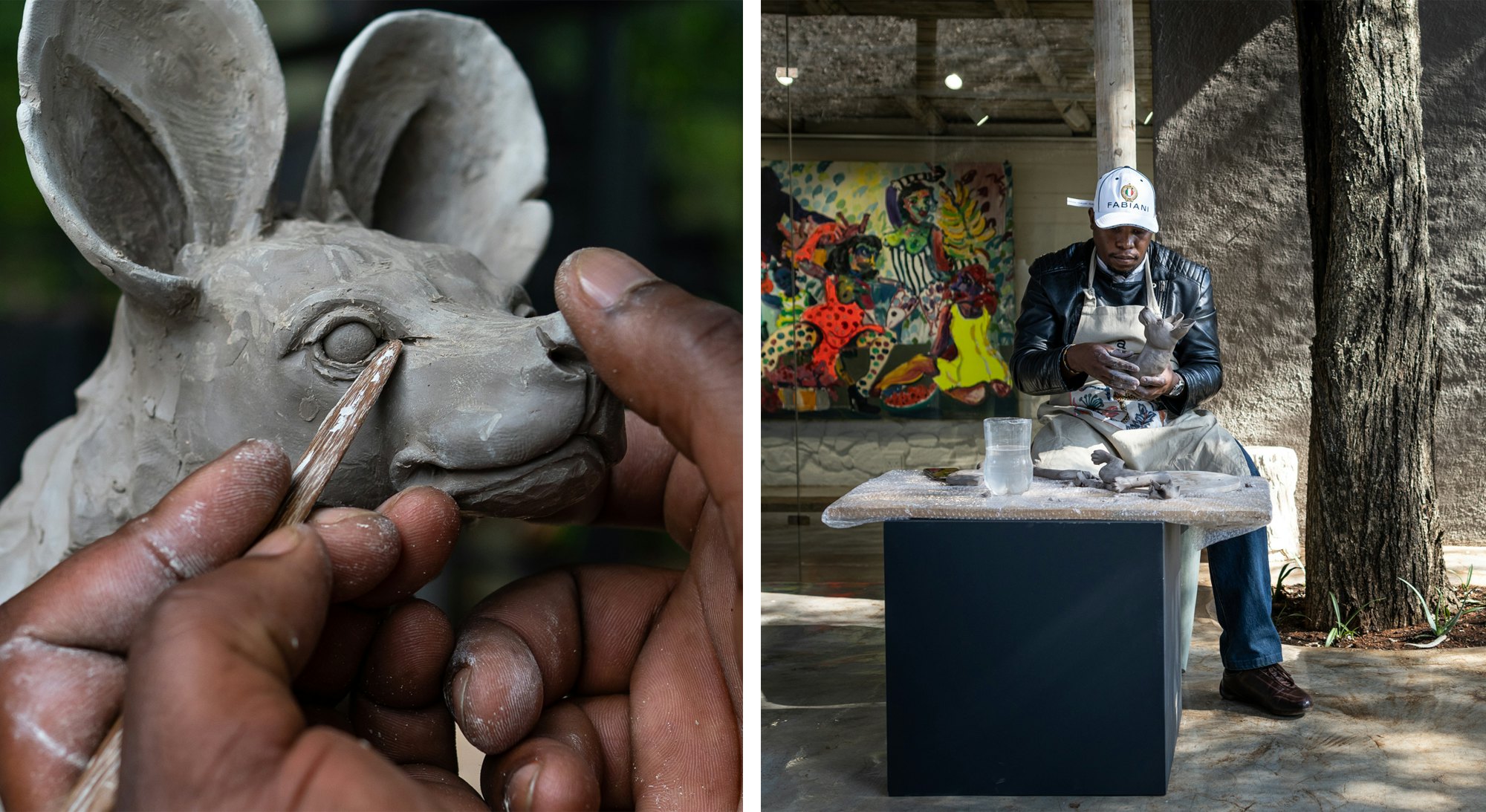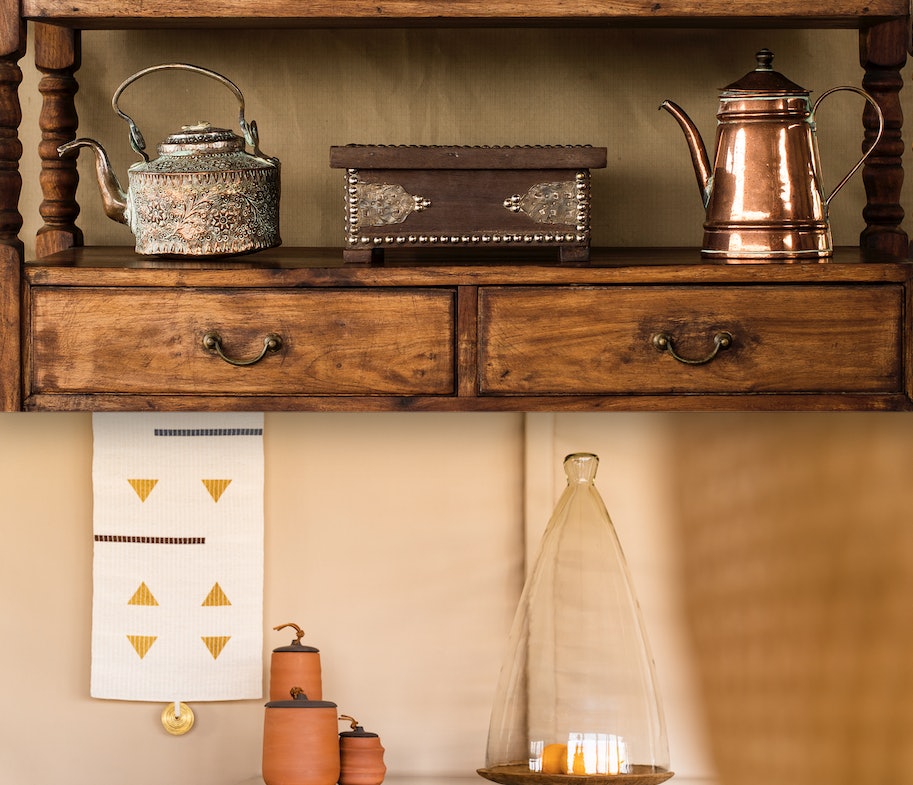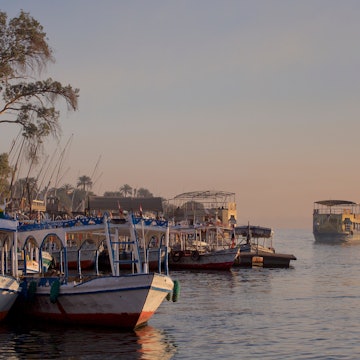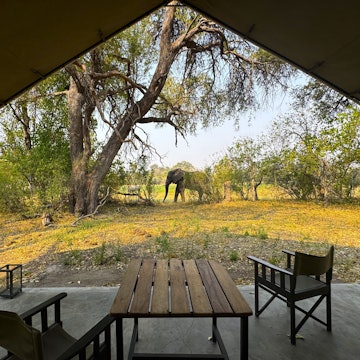
How African safari lodges are putting local creativity front and center

Jan 12, 2023 • 9 min read

Design details at Bisate Lodge in Volcanoes National Park are a celebration of Rwandan culture and the surrounding landscape © Wilderness
For decades, safari hotel design has been dominated by colonial tropes. Thankfully, that’s starting to change.
As I warmed up by a roaring fire in the lounge of the Asilia Naboisho Camp after a sunset game drive, my eyes were drawn to the massive, beaded centerpiece above the mantle. I immediately recalled what my Maasai guide had shared earlier about the impressive wall decor. It is influenced by Enkarewa, a traditional handmade wedding necklace worn by brides in the communities surrounding the Maasai Mara conservancy, he had explained. The vibrant colors and design of each necklace symbolize the alliance between families and the coming together of the community. This particular piece was made by female artists supported by a local nonprofit called the Maa Trust.
Staring at the piece, I felt something beyond the nature-induced awe so many feel when visiting this part of the world. I also felt inspired to learn about and connect with the Maasai people.

A shifting aesthetic
The choice made by Asilia Africa to so prominently display the necklace may seem to some like the obvious one to make. But it is actually a relatively recent phenomenon, part of an encouraging trend among newer and renovated lodges and camps throughout east and southern Africa.
Over the past decade, an interior design renaissance has taken flight in Kenya, Tanzania, Rwanda, Namibia, Botswana, Mozambique, Zimbabwe and South Africa. Luxury properties are shifting away from an "Out of Africa"-influenced colonial theme and embracing a modern aesthetic, celebrating the region’s people, cultural expressions and surroundings. Simultaneously, this change is helping uplift communities, aid conservation efforts, and empower artists and women.

Gone are the vintage trunks at the edge of four poster beds and pith helmets hanging from canvas walls; no more so-called “campaign furniture” (easily foldable pieces used by empire builders in Asia and Africa) and vintage cars glamorizing a painful, bygone era. Instead, these contemporary spaces are being adorned with the brilliant artistry, colors and themes of their respective regions. Guests can find intricate beadwork, woven baskets, hand-tooled wooden utensils and food boards, all locally sourced and created, combined with art galleries showcasing Africa’s emerging artists and architectural elements reflecting the area’s natural beauty.
“If you just use a classic interpretation of Africa that has been done in every single region, it doesn’t tell the story of the area that you're in,” said Caline Williams-Wynn, the South African-based interior designer behind some of the most sought-after safari properties on the continent. “You need to bring people out of their comfort zone and immerse them in the culture of the country and of the people.”
The beginnings of the shift
This shift, according to Cape Town-based public relations consultant, Mercedes Bailey, began at safari properties in South Africa and migrated north, notably to Botswana. The impetus for this change was competition. “As more properties opened in prime safari areas like the Sabi Sands and Okavango Delta, they needed to differentiate themselves; one way to do this was through more modern and cutting-edge design,” Bailey said.
Properties now work with African designers, artists and artisans, showcasing the continent’s creativity, offering a statement that African design doesn't need to fall into a visitor's conception of what that should mean. Along with the cultural revival at the forefront comes another revolution: design that allows the stunning environment to speak for itself. Singita’s Lebombo Lodge, built in Kruger National Park in 2003, is among the earliest lodges to do so. The lodge, with its organic structures filled with natural light – inspired by eagles’ nests built into the cliff face of the riverbank – is among their most iconic.

Singita has 15 lodges across four different regions, including some of the oldest on the continent, a majority of which feature contemporary design celebrating regional culture. In 2020, Singita completely rebuilt and renovated its Sabora Tented Camp in the Serengeti, repudiating its former colonial theme. Each of the luxury rooms, which featured pedestal fans, crystal decanter sets, stacked vintage trunks, hanging lanterns and copper tea kettles evoking an era of European dominance, has been transformed. It’s now a serene oasis, in monochromatic color to reflect the grasslands of the Serengeti and featuring beadwork and pottery to pay homage to its people.
Allowing regional culture to shine
Unlike South Africa and Kenya’s long colonial legacy, with properties dating back to the 50s and 60s, Rwanda's lodges – which opened after the 1994 genocide – started embracing the contemporary shift towards cultural celebration early on, according to Teta Isibo, a Rwandan fashion designer and founder of Inzuki Designs. Isibo collaborated with Willians-Wynn on the brand-new Wilderness Bisate Rwanda Day Lounge near Volcanoes National Park.

“I think when you travel to a country, you want to feel its uniqueness. You want to enter your bedroom and be like, ‘oh wow, this is Rwanda,’” Isibo said.
At Bisate, everything from the thatched architecture and colorful textiles to the tables and woven laundry baskets is a celebration of Rwandan lifestyle, culture and the surrounding rolling hills. “Literally everything you look at, you have a question about – what is this made of? I think that's part of the beauty of traveling, to feel like you're somewhere different,” Isibo said.
The goal for Bisate was to fuse the work of these artists with what’s trending and to create design elements that are uniquely Rwandan. Isibo worked directly with local artisans and translated the designs for the sophisticated and welcoming day lounge.

One&Only Nyungwe House, a resort located in the southwest corner of Rwanda near Nyungwe National Park, has taken cultural revival a step further by offering Imigongo lessons for its guests. Imigongo is an age-old Rwandan art form and a significant part of the culture. Displayed throughout the resort, Imigongo art pieces are geometric in design, with zigzag or spiral patterns. “Color is created through the use of natural soils and organic material and reflects the colors of the earth in Rwanda,” Grace Uwingeneye, guest experience supervisor at One&Only Nyungwe House, explained.
“The Imigongo experience is an opportunity for guests to learn the history of this art from artisan experts, whereby guests are shown how to translate their creativity into fine art,” said Jeannine Umutoniwase, the chief executive officer of Azizi Life, a social enterprise that works with safari lodges and arranges cultural experiences.
Guests not only learn about this ancient art form but also take home a piece of history and culture with their own Imigongo artwork. “We always suggest that our guests learn about the destination and experience the country through a local’s lens, immersing themselves in each part of Rwanda, from conservation to nature to cultural customs,” said Uwingeneye.

Where art inspires conservation
Newly celebrated design principles across the continent partially stem from the belief that art has the power to inform and enrich a safari and, in some cases, aid conservation. Wildlife viewing in Africa is a life-changing experience, and one is often left feeling a deep desire to protect these animals, some of which are on the brink of extinction.
In Rwanda, the new Bisate day lounge features rows of photographs of individuals from nearby villages, a decision that is “all about acknowledging all the people that are part of the conservation [of the mountain gorilla] in that area,” according to Williams-Wynn. Because the lounge is designed for early arrivals to relax before check-in or for guests to freshen up after hiking before departure, there is an opportunity to admire the photos and learn their stories. Knowing the hard work that went into conserving the habitat and its endangered animals that made the gorilla trekking possible makes the journey all the more rewarding, rather than just checking off a bucket list item or posting on social media.
Elsewhere on the continent, Singita recently partnered with Ardmore Ceramics Design, an artist community based in KwaZulu-Natal, South Africa, to open contemporary African art galleries in Singita Sabi Sand and Singita Kruger National Park. The collaboration resulted in an Artist in Residency program at Singita Sabi Sand for a sculptor and painter pair with a twofold goal: to showcase the beauty of Africa through its people and art, and conserve its natural heritage by raising awareness and funds for the non-profit Singita Lowveld Trust (SLT).

The artists observe the flora and fauna to create artwork of local wildlife, and they often interact with the guests. “I feel very proud to have my work featured at Singita’s lodges,” said Senzo President Ntshalintshali, one of the creatives selected as an Artist in Residence. “I would like to see my work give back in some way and make a difference in the protection of animals so that future generations are not robbed of these amazing species.”
Working with the community
This evolution of safari design – from whitewashed fantasy to celebration of local art – is mutually beneficial to communities. By hiring regional artists and artisans and sourcing materials locally rather than importing from overseas, safari companies are reducing their footprint and showing their commitment to the people.

When Isibo was starting out in the business, she found that “everything that was locally made was really cheap trinkets, souvenirs for tourists.” Now, with high-end safari companies investing in creatives to produce unique designs, Isibo believes, “Rwandan artisans have really started understanding the worth of their product.”
Being able to sell their wares at the shops in the safari lodges and camps sustains local artists. Azizi Life, which provides lodges with handcrafts for giving out as gifts to guests, or to decorate or use in the rooms (in addition to bringing Rwandan pieces to the world), supports 711 artisans (634 women and 77 men). “I am proud to see how we are improving the lives of our artisan partners in general; they can send their kids to school, pay health insurance and invest in livelihood stock which they were unable to do before working with Azizi Life,” Umutoniwase said.
On the day after my encounter with the Enkarewa at Naboisho Camp, I booked a guest experience to visit the Maa Trust, the local non-profit behind the beaded wall hanging. There, I learned about the Trust’s work to empower women by promoting small business startups, such as the beadwork project. Their beaded products are sold at various camps in the Conservancy and ethical shops around the globe.

Before leaving, I purchased beaded jewelry and a woven blanket. There was a time, not too long ago, when travelers would come home with ivory ornaments; or, more recently, mass-produced trinkets. Now, thanks to the efforts of local artists, I can bring home a piece of creative expression – one that I was able to witness from beginning to end. It’s a piece of art that brings me back to that community visit in Maasai Mara, gorilla trek in Rwanda or safari in South Africa. There is still more work to be done. As long as people seek antiquated visions of what constitutes safari camps, they will continue to exist. But now, more than ever, travelers can choose to have an African safari experience that weaves in the narrative of the region’s people, not its colonizers.













